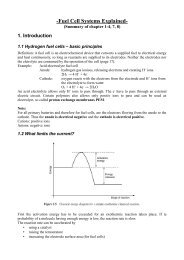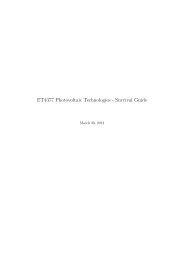Fuel Cell Systems Explained - from and for SET students
Fuel Cell Systems Explained - from and for SET students
Fuel Cell Systems Explained - from and for SET students
You also want an ePaper? Increase the reach of your titles
YUMPU automatically turns print PDFs into web optimized ePapers that Google loves.
4.6 PEMFC connection – the bipolare plateBipolar plates are difficult to manufacture, <strong>and</strong> made up almost all volume <strong>and</strong> mass of a fuel cell,thus they are also a high proportion of the cost of a PEMFC stack.4.6.2 Flow field patterns on the bipolar platesIn the bipolar plate the reactants are fed over the electrode in a fairly dimple pattern or parrallelgrooves. The parallel system has the problem that impurities, like notrogen, can block one groove,<strong>and</strong> there<strong>for</strong>e leading an area of the electrode unsupplied. This leads to a more serpentine pattern.The problem with this pattern is the longer path length abd the large numbers of turns in the gasflow. That means more work <strong>and</strong> thus more energy is needed to push the gas through.The grooves are very narrow, less than 1mm 2 . In order <strong>for</strong> water droplets not to <strong>for</strong>m, the system isarranged so that the pressure drop along a channel is greater than the surface tension holding awater droplet in place. That has to work even when the gas suuply is stopped. The latestdevelopment by Ballard is a rectangular plate, several times longer than wide, with long straightchannels, which have a high pressure drop <strong>and</strong> no inefficient bends <strong>and</strong> turns.4.6.3 Making bipolar plates <strong>for</strong> PEMFCsThe bipolare plate has many tasks in the cell. Collecting <strong>and</strong> conducting the current <strong>from</strong> the anodeto the cathode of the next cell, evenly distributing the fuel to the anode <strong>and</strong> oxygen/air to thecathode <strong>and</strong> sometimes carrying a cooling fluid. Furthermore keeping all the gases <strong>and</strong> fluids apart<strong>from</strong> each other <strong>and</strong> contain the reactant gases within the cell.Requirements: electric conductivity > 10 S/cm heat conductivity > 20 W/mK with additional cooling <strong>and</strong> > 100 W/mK withoutgas permeability < 10 -7 mbarL/scm 2 corrosion resistant stiff, flexural strength > 25 Mpa low costs slim <strong>for</strong> min stack volume light <strong>for</strong> min stack weight short production timeThe materials <strong>and</strong> production method used, varies considerably. In terms of easier manufacture theplates are often made in two halves. Then, the cooling channels can be cutted <strong>and</strong> don't have to bedrilled into the plate. The most commonly used materials <strong>and</strong> methods are: machining of graphit paperellectrically conductive, reasonably easy to machine, low densityDisadvantages: long machining time, brittle so careful h<strong>and</strong>ling needed, porous so a few mmthickness is needed inection molding of graphite filled polymercheap, short production timeDisadvantages: poor conductivity, needs further developments compression moulding of a graphite <strong>and</strong> thermoplastic polymer granuleshigher proportion of graphit, so better conductivity, but not so fast as injection moulding. Carbon-carbon compositethe complex shape of the surface is moulded <strong>and</strong> then applied to a solid carbon back plate, in orderto get a higher stiffness, lower gas premeability <strong>and</strong> sufficiently flat plate. Stainless steelgood electrical <strong>and</strong> heat conductor, not porous so thin, can be machined easily.Disadvantages: heavy, expensive Per<strong>for</strong>ated or foamed metal






